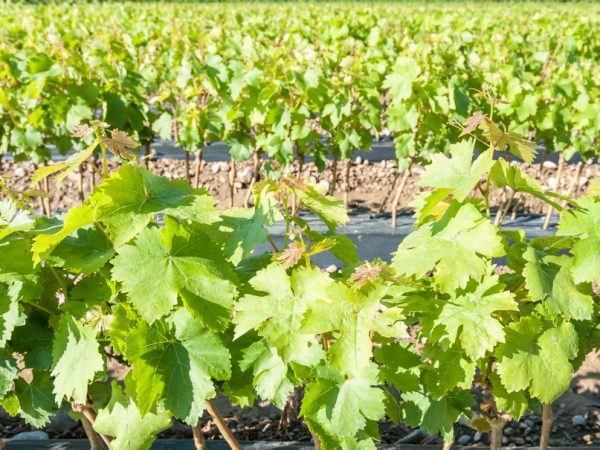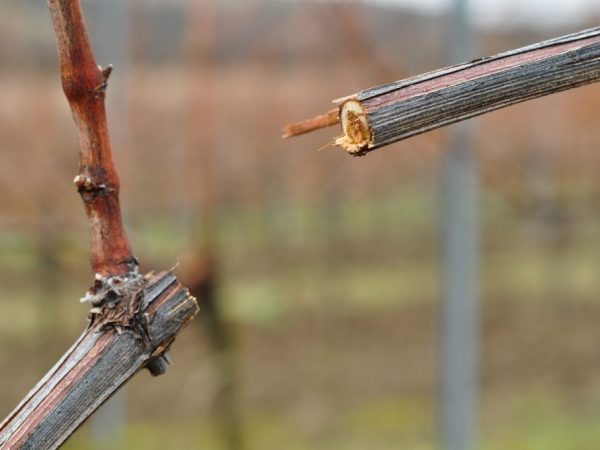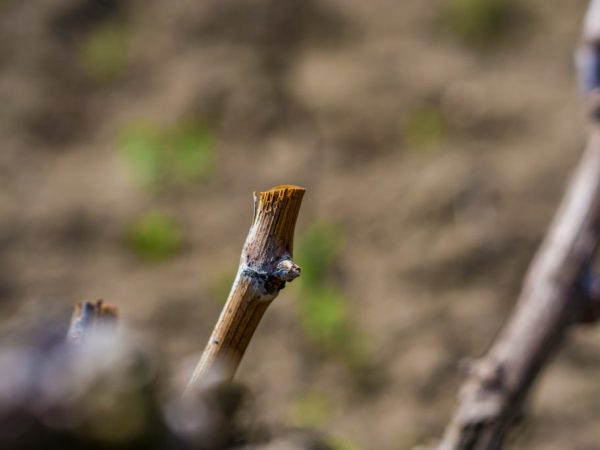All about grafting grapes
Grafting of grapes helps to achieve a good result in cultivation. This process helps to strengthen the plant's immunity, increase frost resistance, and increase yields. A gardener can replace an old variety with another, as well as get several types of crops on one bush. Manipulations are performed in different ways.

All about grafting grapes
Required inventory
The result depends on the accuracy of the process. The choice of tools plays a big role. Among them should be:
- grafting secateurs;
- hammer or block of wood;
- bit;
- small ax;
- garden knives;
- a hacksaw with fine teeth.
Cutting objects should be well sharpened. All equipment is disinfected to avoid contamination of the plant with diseases. It is also worth preparing cut plastic wrap, twine, burlap.
Rootstock selection
Bushes aged 3-5 years are suitable for grafting grapes. They are distinguished by high survival rate. It's good when the stock has the following properties:
- vigor;
- the presence of a strong underground trunk;
- resistance to common diseases.
A wild or semi-wild variety is often chosen as the rootstock. They are immune to mildew and powdery mildew, but are attacked by anthracnose. It is easier to carry out the procedure on young plants.
The most suitable varieties for grafting manipulations:
- North American selection: Riparia, Rupestris, Solonis;
- European selection: Kober 5BB, RR 101-14.
They are resistant to phylloxera and fungal diseases. If the grafting is scheduled for the spring, the stock is pruned in the fall.
Scion preparation
Cuttings are harvested in autumn or spring. They should be:
- healthy;
- straight;
- pencil thick;
- length 9-12 cm.
For storage, the shanks are wrapped in a damp cloth and plastic wrap. The temperature of the content is 0 ° С-2 ° С. Shoots are periodically inspected, washed if necessary. A few days before grafting, the cuttings are placed in water.
For spring pruning, the scion is also kept in water. This is done so that the cut does not dry out. When greenery appears, low-quality shanks are discarded. The rootstock and the scion must have the same vigor.
How to vaccinate

It is desirable to carry out the procedure in the morning or in the evening.
There are different ways of grafting grapes. Each of them is applied within a certain time frame according to strict rules. Manipulations are performed at temperatures above 15 ° C. Better to produce them in the morning or evening. During this period, air humidity and sap flow in the grapes contribute to the effectiveness of the process.
Cleavage grafting
Split grafting is the most popular method in viticulture. Even beginners are capable of performing it, since the procedure is simple and reliable.
It includes several ways of grafting grapes:
- Black to Black. Produced in early spring, when the shanks and bush are half asleep. Cuttings are harvested in the fall.
- "Black to Green". Perform in the summer. Chubuk last year is grafted onto a bush with not yet lignified shoots.
- Green to green. Performed in summer or autumn. Cuttings and shoots that have ripened in the current year are used.
To carry out the vaccination, the stock is first prepared:
- dig in to a depth of 25-30 cm;
- the root stamp is cleaned and cut so that a stump of 5-6 cm remains above the lower node;
- the cut is cleaned and covered with damp material.
The stalk is cut off. The blade should be 3 cm in size. Grafting of grapes into the split is carried out exactly in the middle. The indentation in the hemp should be the same size as the blade. The chubuk is inserted into the stock according to the following recommendations:
- the outer parts of the hemp and the wedge are combined;
- the kidney is turned in the other direction (outward).
The remaining gap in the cleft is sealed with damp toilet paper and covered with a strip of polyethylene. Then they wrap it with a strip of natural fabric (it decomposes well in the soil). The stock together with the scion is covered so that there is 5-6 cm of earth above the upper eye.
Desktop way
This is a winter procedure. Lead time is February or early March. Produced at home. The prepared cuttings are placed in water for several days. When the eyes begin to sprout, an oblique incision or split is made. The cut is made 2-3 cm below the eyes. Connect and fix with a cloth or strips of film. The top is covered with sawdust, which will retain moisture, and a film. The temperature of the content should be constantly 20 ° C. The seedlings obtained as a result of table grafting are planted in the spring.
Grafting in a stem
Produced from the beginning of sap flow until the end of May. Remove up to 10 cm of soil around the trunk. Cleaned from old bark, wipe with a rag. Install a minimum of 2 scions.
When grafting grapes into a stem, the top of the bush is cut off. The place of the cut is cleaned and a split is made with a depth of 3-5 cm. So that it does not split, the stock is tied with twine at the knot. Drive in a wedge. The junction is coated with plasticine, tied and sprinkled with earth. When the first shoots appear, the earth is raked.
Drill grafting

Plants are grafted in spring
The term of the work is spring. Drill grafting is often used in place of the splitting method. To perform the procedure, take a drill, treat it with a disinfectant. A hole is made on the trunk perpendicular to the trunk. A stalk is inserted into it, on which the cut is updated. Bare tissue should be in contact.
The grafting of grapes by drilling is distinguished by the strength of the connection and the speed of execution. It does not require tying. It is characterized by good performance.
Sometimes grapes are grafted onto mulberries or actinidia. This is rarely done, since the survival rate is not always good. Vaccination manipulations are as follows:
- a hole is made in the stock with a drill;
- a peeled handle is inserted into the hole;
- if it turned out to grow together the plants, the mulberry shoot is separated and planted separately.
Summer vaccinations
The procedures at this time are distinguished by their effectiveness, since the life processes of culture are active. It so happens that after the summer grafting, the grapes begin to cry. This indicates that the actions were performed incorrectly.
Budding
This is the name of the green grape grafting. The production period is from mid-June to mid-August. Shoots with a thickness of more than 6 mm are suitable for budding. The shanks are cut on the day of vaccination. They are used for several hours.
The first procedure is performed on the node, which is located at a distance of 60 cm from the base of the shoot. The next ones are after 50 cm.
Manipulations are performed step by step:
- A 2-2.5 cm flap is cut out in the rootstock: an incision (2 mm) is made at an angle of 45 ° below the peephole by 1.5 cm, then cut from above above the peephole and removed.
- A shield with a peephole is cut from the cutting (the size should match the cut on the rootstock).
- Combine and oblige with polyethylene strips. Coils begin to be made from the base of the flap, moving upward (the peephole is not closed).
- After 1-1.5 months, the harness is removed.
- Before frost, the grafted shanks are cut off.
- Disembarkation is carried out in the spring, according to the rules.
Simple copulation
Copulation is performed from mid-May to late June. The same applies to green grafting of grapes. A few days before the start of the procedure, the bushes are prepared:
- break off branches, leave 4-5 strongest;
- from the rest, remove all vegetative organs, kidneys, pinch the tops;
- watering.
The bush is ready for the procedure when sap is released on the cut. Further actions are as follows:
- above the rootstock shoot knot, an oblique cut of 2-3 cm is made (from the side of the former bud);
- the same manipulations are performed with the handle (under the kidney);
- the places of the cuts are combined;
- tied with strips of polyethylene.
The last action is difficult to perform, but the fusion is good.
Combined vaccination

There are many ways to graft grapes
For this method, lignified cuttings and a green shoot are used. Chubuki are soaked by adding stimulating drugs to the water. Then they are cut so that 1-2 eyes remain on each. Paraffin: immersed in paraffin heated to 80 ° C-85 ° C and immediately removed, placed in cold water for a couple of seconds.
Inoculating grapes using the combined method should be like this:
- The stalk is cut into a wedge on both sides 1-2 cm below the peephole. Placed in water.
- An incision is made above the third node from the base of the shoot. 1-1.5 cm should remain from the cleft to the knot.
- Insert a shank into it.
- Obligate the entire vaccination area with a strip of gum.
- A tube is put on top.
Kilchev method
To perform the procedure, a well-lit area is chosen. At the end of February, it is covered with straw. Dig a hole just before kilchevanie. A bunch of cuttings is immediately placed in it. They should be buried by 15 cm. Then the shafts are covered with a layer of 10 cm moistened with earth. Then the manure is laid in a layer of 1 cm. The pit is covered with plastic wrap. It is opened if the ground temperature rises above 28 ° C. Cover with straw at night.
On sunny days, the process lasts 12-15 days, on cloudy days - 20 days. Kilchevanie ends when a drop appears on the underside of the shanks and roots begin to form. Cuttings are selected for planting, from which the buds swell on the other side.
Grafted vine care
Under appropriate conditions, the plant will develop correctly, so it is worth following certain rules. A week after performing the vaccination manipulations, moderate watering is performed (if necessary). To do this, use warm water. The soil around the trunk is loosened. Weeding is carried out at the same time. Excess grafts and shoots are removed so that the vine does not weaken. The plant is treated for diseases.
Cuttings grow together with the stock for 30-40 days. If the process is successful, new shoots appear. If the scion has not taken root, the plant continues to be looked after. Then you can try again next season.
Conclusion
Thanks to the grafting of a new grape variety on an old bush, they significantly save space on the site. Manipulation contributes to an increase in the early maturity of fruits, an increase in their size and color change.
You always need to correctly select the timing of the procedure. It is worth making sure that the strapping is tight. If all conditions are met, the vine will delight you with a good harvest.


